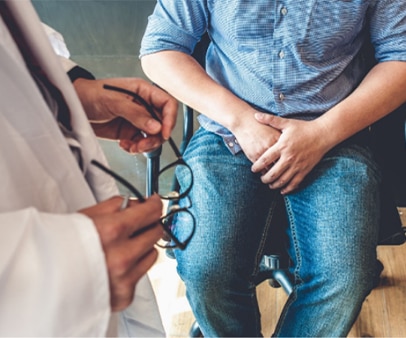About Inguinal Hernias
Accounting for 75% of all hernias, inguinal hernias (or groin hernias) occur when part of your bowel protrudes into the passageway that runs down your inner thigh (the inguinal canal).1 They affect men or people assigned male at birth (AMAB) 8x more likely, but can also affect women and children.2 There are two types of inguinal hernias:
- Indirect Inguinal Hernia: The most common type of inguinal hernia and the one that usually occurs due to a birth defect, indirect inguinal hernias enter your inguinal canal through the top.3
- Direct Inguinal Hernia: Occurring more often in men than women, a direct inguinal hernia is caused by the weakening of abdominal muscles or chronic pressure on the muscle wall over time.3 Unlike indirect inguinal hernias, direct inguinal hernias penetrate directly through the wall of your inguinal canal versus through the top.
While inguinal hernias aren’t necessarily dangerous, they can lead to life-threatening complications. Should your inguinal hernia cause pain or become enlarged, your doctor may recommend surgery.
Common Symptoms of Inguinal Hernias in Adults
- Pressure or heaviness in the groin.
- Dull pain in the groin, especially while lifting, coughing, straining, or bending over.
- A burning or pinching sensation through your pelvis or down your leg.
If you have symptoms of an inguinal hernia, it’s important to have it diagnosed as soon as possible to rule out other possible causes of groin pain. Contact your healthcare provider immediately if you experience adverse symptoms/complications, including:
- Fever or chills
- Nausea or vomiting
- Difficulty urinating or passing a bowel movement
- Increased pain, swelling, redness, tenderness
- If your hernia increases in size or becomes incarcerated and can’t be pushed back inside
These may signify a serious condition called ‘strangulation’ where an obstruction of your intestines can cut off blood flow causing intestinal or bowel tissue to die. Strangulation can happen in all hernias but is more common in femoral and inguinal due to their narrow ‘necks.’3
Common Symptoms of Inguinal Hernias in Children2
Inguinal hernias can occur in newborns and children due to a weakness in the abdominal wall that’s present from birth. The hernia may only be visible when the infant or child is crying, coughing, or straining during a bowel movement. He/she may have a decreased appetite or be more irritable than normal. If you’re concerned your child has a hernia, consult their pediatrician.
Potential Causes of Inguinal Hernias2
Inguinal hernias occur when there’s a weakness or opening in the lower abdominal wall that allows tissue to push through. Contributing factors may include:
- Age
- An opening or weak spot present at birth or from previous abdominal surgery
- Chronic coughing or sneezing
- Straining during bowel movements or urination
- Frequent, strenuous exercise, lifting, or manual labor
- Obesity
- Pregnancy
Ways to Diagnose Inguinal Hernias1,2
To identify whether or not you have an inguinal hernia, your healthcare provider will likely begin with a physical examination. During the exam, you may be asked to stand and cough to make the hernia appear bigger. If the hernia isn’t visible from the outside, imaging tests including an ultrasound or CT scan may be performed.
Treatments for Inguinal Hernias1
Treating an inguinal hernia typically requires surgery. Most hernia repairs can be managed by minimally invasive surgery methods, but hernias that are more complicated may require open surgery. The type of surgery you have will depend on your condition, prior surgical history, and the judgment of your surgeon.
Surgical Treatment
There are three primary surgical options for hernia repair: open, laparoscopic, and robotic. The appropriate type of surgery for you may depend on the size, severity, and location of your hernia. Ask your doctor about which option is right for you.
- Open Surgery: As the traditional surgical method, an open surgical procedure involves making a large incision over the area of the hernia. The hernia bulge is returned to its correct position and a mesh is often placed to help strengthen and support the weakened area before closing up the incision.
- Laparoscopic Surgery: A surgeon will use several small, key-hole sized incisions during laparoscopic surgery. Instruments, such as a camera, are then inserted through the incisions to perform the operation.
- Robotic Surgery: Similar to laparoscopic surgery, robotic surgery uses several smaller incisions. The surgeon performs the operation from a console located in the operating room.
Learn more about surgical techniques here.
What Are the Next Steps to Treat an Inguinal Hernia?
If you have symptoms of an inguinal hernia, contact your healthcare provider as soon as possible to have it diagnosed and to rule out other possible causes of pain.
The guidance provided in this article follows general rules that should be discussed with your doctor. This article is for informational and educational purposes only. It does not substitute for medical advice. If in doubt, always consult your doctor.
Related Articles
Join the HerniaInfo.com community! Get notified about our latest articles and updates on all things hernia as they become available.
References
- https://my.clevelandclinic.org/health/diseases/16266-inguinal-hernia
- https://www.mayoclinic.org/diseases-conditions/inguinal-hernia/symptoms-causes/syc-20351547
- https://generalsurgery.ucsf.edu/conditions--procedures/inguinal-hernia.aspx
- https://www.hopkinsmedicine.org/health/conditions-and-diseases/hernias/inguinal-hernia
This site is not intended as a substitute for professional medical care. Only your physician can diagnose and appropriately treat your symptoms. BD does not recommend the use of any particular physician or team of physicians. Please consult your healthcare provider for advice regarding who should be part of your hernia repair team.
BD-90440


